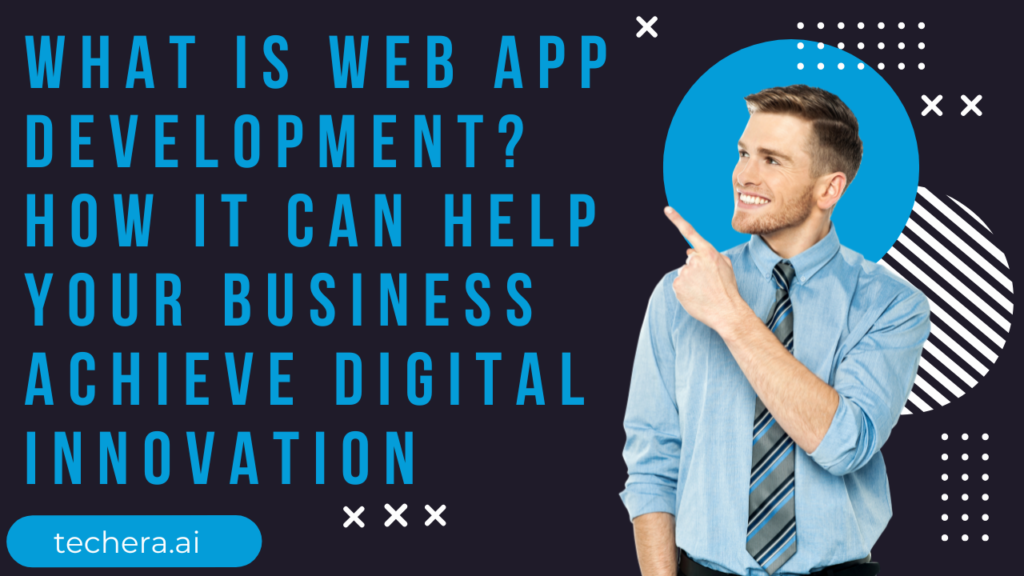
Discover the essentials of What is Web App Development and learn how it can drive digital innovation for your business. This blog post breaks down the development process, key benefits, and how web applications can boost efficiency, customer engagement, and competitive edge in today’s digital landscape.
Introduction
Understanding Web App Development
So, what is web app development, really? reating the application software that runs in your internet browser is part of it. You don’t have to download anything—just open a browser, and boom, the app is ready to roll. From Gmail to Canva, web apps have become the backbone of modern business tools.
The Importance of Digital Innovation for Businesses
We’re living in a digital-first world. If your business isn’t evolving with tech, you’re basically running uphill… in flip-flops. Digital innovation is more than just a catchphrase; it’s how businesses remain efficient, competitive, and relevant.
The Basics of Web App Development
Definition and Core Concept
Programs that may be accessed through a web browser are known as web apps. Web apps handle data, react to user input, and provide interactive features, in contrast to static websites.
Web App vs Website vs Mobile App
- Website: Mostly informational (think blogs or company sites).
- Web App: Interactive tools (like online banking, dashboards).
- Mobile App: Installed on phones, but many modern web apps offer similar performance through mobile browsers or PWAs.
Types of Web Applications
Static Web Applications
Lightweight and straightforward—not interactive, but effective for displaying content.
Dynamic Web Applications
These apps respond to user inputs and generate data on the fly (e.g., Netflix or Instagram).
Single Page Applications (SPAs)
Everything loads in one HTML page, and JavaScript handles the rest. Think Gmail or Trello.
Progressive Web Apps (PWAs)
combines the greatest features of webpages and mobile apps—it’s dependable, quick, and even functional when not in use.
Key Components of Web App Development
Frontend Development
This is the user-facing part. It includes:
- HTML for structure
- CSS for styling
- JavaScript for interactivity
Backend Development
Behind the curtain, handling logic, authentication, and databases. Tech stacks include:
- Node.js, Python, PHP
- Databases like MongoDB, MySQL, PostgreSQL
DevOps & Cloud Deployment
Deployment involves tools like AWS, Azure, or Heroku—ensuring scalability, security, and uptime.
The Web App Development Lifecycle
Step 1: Ideation & Planning
Clarify the app’s purpose, user goals, and technical needs.
Step 2: Market & User Research
Interview users, run surveys, analyze competitors—build what people actually need.
Step 3: UI/UX Design
Sketch interfaces, map user flows, and create engaging mockups using Figma or Sketch.
Step 4: Development (Frontend & Backend)
Separate the client-side and server-side coding tasks.
Step 5: Testing & Quality Assurance
Test usability, functionality, performance, and security both manually and automatically.
Step 6: Launch & Deployment
Go live! Push the final build to production servers.
Step 7: Post-Launch Support & Iteration
Fix problems, get user feedback, and add fresh features.
Why Web App Development Matters for Business

Streamlining Business Operations
Automate everything from HR tasks to inventory management.
Enhancing Customer Experience
Offer intuitive, personalized experiences that drive retention.
Real-Time Data & Analytics
Track customer behavior and business performance as it happens.
Cross-Platform Accessibility
Users can access your app from any device—no downloads required.
Driving Digital Innovation Through Web Apps
Adopting Agile Methodologies
Iterate fast, launch often, and pivot with feedback.
Leveraging Cloud & AI Technologies
Integrate machine learning or use cloud-native features to scale effortlessly.
Automation of Routine Tasks
From scheduling to notifications, free your team from manual workflows.
Creating Scalable Infrastructure
Build once, scale infinitely—with cloud deployment and containerization.
Also Read : What is Web App Development? A Step-by-Step Guide for Business Owners
Benefits of Embracing Web App Development
- Cost Efficiency: Build once, run everywhere.
- Customization & Control: Tailor every element to suit your business.
- Faster Time-to-Market: Launch MVPs and test ideas quicker.
- Competitive Advantage: Stay ahead by offering smarter digital tools.
Selecting the Appropriate Technology Stack for Your Web App
- Frontend: React, Vue, Angular
- Backend: Node.js, Django, Laravel
- Database: MongoDB, PostgreSQL, Firebase
- Hosting: AWS, DigitalOcean, Netlify
Challenges in Web App Development
- Security Concerns: Always use HTTPS, input validation, and secure authentication.
- Scalability Issues: Plan for growth from day one.
- User Adoption & Training: Make your app intuitive and provide onboarding.
- Keeping Up with Tech: Stay updated or partner with someone who is.
How to Get Started with Web App Development

- Comparing in-house with outsourcing, in-house offers greater control, while outsourcing is excellent for speed.
- Setting KPIs: Track usage, engagement, conversions.
- Budgeting & Timelines: Always leave room for testing and iteration.
Success Stories: Businesses Innovating with Web Apps
Case Study 1: Retail Brand’s E-Commerce Transformation
A traditional clothing brand launched a custom web app and saw a 200% increase in mobile orders.
Case Study 2: SaaS Company’s Customer Portal
A software startup built a self-service dashboard, reducing customer support tickets by 60%.
Future Trends in Web App Development
- Integration of AI and ML: Predictive analysis, automation, and intelligent recommendations.
- Voice and Gesture Interfaces: Beyond typing—more accessibility and ease.
- Web3 & Decentralized Apps: Blockchain meets web apps. Ownership and privacy redefined.
Conclusion
What is Web app development and it no longer optional—it’s foundational. It serves as a link between your company’s objectives and online success. Whether you’re streamlining operations, innovating services, or reaching new audiences, web apps give you the tools to transform ideas into interactive experiences. Digital innovation starts with a single step—building a web app tailored to your business needs.
Frequently Asked Question
Q. What is web app development and how does it differ from websites?
A. Web app development involves creating interactive, browser-based applications, while websites are often static and informational.
Q. How can web apps help small businesses grow?
A. They automate tasks, improve customer engagement, and provide valuable insights through analytics.
Q. Is custom web app development expensive?
A. Costs vary, but custom apps are long-term investments with high ROI due to efficiency and scalability.
Q. How do I secure my web application?
A. Use encryption, strong authentication, and regular security audits to keep data safe.
Q. What industries benefit most from web app development?
A. Retail, education, healthcare, finance, and SaaS businesses see major advantages from web apps.

